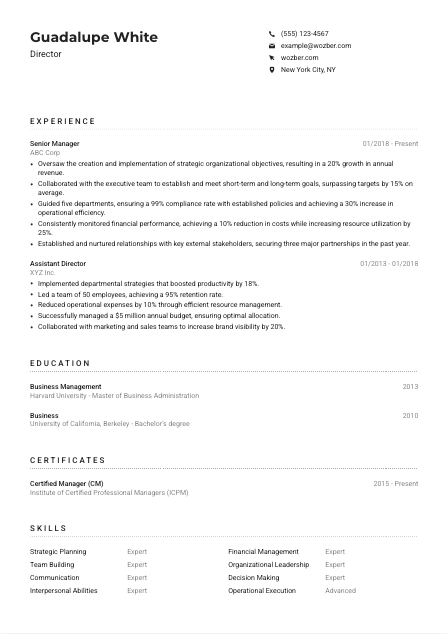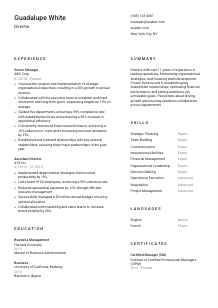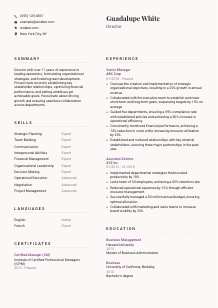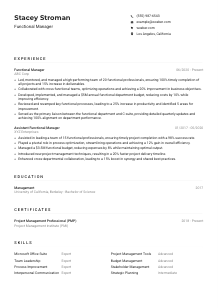Director CV Example
Leading the charge, but your CV doesn't command attention? Navigate this Director CV example, honed with Wozber free CV builder. Grasp how you can position your strategic insights to resonate with top-tier job expectations, setting your career trajectory towards boardroom excellence!

How to write a Director CV?
Stepping into the shoes of a Director requires more than leadership—it demands vision, strategic execution, and the ability to foster growth at every turn. Your CV is not just a document; it's your personal battle standard, unfurled to announce your readiness to lead. With the Wozber free CV builder at your side, we're diving into the art of tailoring your CV with precision, aligning it perfectly with the intricacies of a Director's role.
Are you ready to craft a CV that doesn't just open doors but knocks them down? Let's get started on turning your career goals into your professional reality.
Personal Details
First impressions are monumental, especially when you're aiming to capture a role of this calibre. The Personal Details section, though brief, sets the formidable tone for what follows. How, then, can we ensure this section not just whispers but announces your readiness for a leadership role? Follow these meticulously crafted steps:
1. Brand Yourself Right
Your name is not just an identifier; it's the flag under which all your achievements rally. Ensure it's prominent, nurturing a sense of respect and authority right off the bat. A touch larger font size can work wonders.
2. Job Title Precision
"Director"—let this title sit right beneath your name like a crown, tailored to the role you're eyeing. This alignment signals to the hiring manager that your aspirations synchronize with their needs.
3. Essential Contact Info
- Phone Number: This is your hotline to opportunity. Double-check it for accuracy; a missed digit could mean a missed chance.
- Professional Email Address: Here's where simplicity meets professionalism. A firstname.lastname@email.com format is sleek, signaling that you're all about keeping things clear and direct.
4. Geo-targeting
By pinpointing "New York City, NY" in your CV, you're addressing one of the job's logistical requirements upfront. It's a nod to the hiring manager that you're already in the arena, ready and waiting.
5. Professional Online Presence
Consider adding a link to your LinkedIn profile or a personal portfolio website. Ensure they are mirrors of your professional life, offering a deeper dive into your career journey.
Takeaway
This opening section is more than just a formality—it's your first volley, setting the stage with precision and professionalism. Keep it sharp, direct, and reflective of the role you desire. This isn't just about making a good first impression; it's about making the right one.





Experience
The Experience section is your battleground, where each bullet point is a testament to your strategic prowess and leadership feats. Crafting this section with care is crucial to showcase your direct alignment with the demands of a Director.
- Oversaw the creation and implementation of strategic organisational objectives, resulting in a 20% growth in annual revenue.
- Collaborated with the executive team to establish and meet short‑term and long‑term goals, surpassing targets by 15% on average.
- Guided five departments, ensuring a 99% compliance rate with established policies and achieving a 30% increase in operational efficiency.
- Consistently monitored financial performance, achieving a 10% reduction in costs while increasing resource utilization by 25%.
- Established and nurtured relationships with key external stakeholders, securing three major partnerships in the past year.
- Implemented departmental strategies that boosted productivity by 18%.
- Led a team of 50 employees, achieving a 95% retention rate.
- Reduced operational expenses by 10% through efficient resource management.
- Successfully managed a $5 million annual budget, ensuring optimal allocation.
- Collaborated with marketing and sales teams to increase brand visibility by 20%.
1. Analyzing the Battlefield
Break down the job requirements, identifying the exact skills and experiences the role demands. This analysis will be your blueprint as you begin to construct your experience narrative.
2. Structuring Your Victories
List your roles in reverse chronological order, starting with your most recent. Each entry should encompass your title, the company's name, and the duration of your tenure. This structure not only highlights your journey but also your progression.
3. Achievement Artillery
For each role, carefully articulate your achievements, focusing on those that resonate with the role you're applying to. If the job description emphasizes "strategic planning," mention how your strategies drove growth or improved efficiency.
4. The Power of Numbers
Quantifying your achievements adds weight to your claims. Did you boost annual revenue by 20% or save costs by 10%? These numbers are your firepower, underscoring your impact in tangible terms.
5. Relevance Over Repertoire
Avoid the temptation to list every single accomplishment. Curate your experiences, focusing on those that closely align with the job's requirements. This isn't just about showing you're capable; it's about proving you're the perfect fit.
Takeaway
Your experience section is a showcase of your leadership journey, each role a chapter in your story of growth and achievement. Craft this narrative with precision, ensuring it speaks directly to the needs and aspirations of your future role. Lead with your strengths, and let each bullet point build the case for why you're the strategic visionary they need.
Education
While the Education section might seem straightforward, it's a vital component of your leadership profile. Here, we'll fine-tune this section to not just list your qualifications but to showcase them as the bedrock of your directorial potential.
1. The Cornerstone of Requirements
Begin with the bedrock: the job's educational prerequisites. This role demands a "Bachelor's degree in Business, Management, or related field." Let your qualifications echo this, placing the most relevant degrees front and center.
2. Structuring Your Academic Pillars
Maintain clarity and conciseness. Kick off with your degree, followed by the field of study, then the institution, and finally, your graduation year. This sleek structure allows hiring managers to quickly gauge your educational background.
3. Tailoring for Impact
If the job prefers a Master's degree, and you have one, make it a highlight. Tailor your degree details to resonate with the job spec, ensuring your education aligns seamlessly with the role's demands.
4. The Added Value of Relevant Courses
While not always necessary for senior positions, listing pertinent courses can underscore your expertise in areas critical to the role. Consider this the fine print that further qualifies your candidacy.
5. Showcasing Academic Achievements
Have you graduated with honors, led a significant project, or been part of clubs or societies relevant to your field? These details, while brief, contribute to a rounded image of your readiness for leadership.
Takeaway
Your educational achievements are not mere entries on a CV; they're the foundational stones of your professional identity. Align them with the role's requirements, showcasing your academic journey as a testament to your preparedness for leadership. It's not just about where you learned, but what you've taken from those experiences.
Certificates
In the expansive realm of leadership, certificates are akin to medals of honor—evidence of your commitment to continuous improvement and mastery in your field. Let's navigate this section to ensure your certificates shine brightly on your CV.
1. Sifting Through the Arsenal
Start by revisiting the job posting. While our example didn't explicitly require certifications, any that demonstrate leadership, strategic acuity, or industry relevance should be front and center.
2. Selecting the Gems
Quality trumps quantity every time. Highlight certifications that directly enhance your candidacy for the Director role. Think of these as your badges of distinction.
3. Dates: The Timeline of Your Growth
Include acquisition dates for recent or particularly relevant certifications to showcase your ongoing dedication to professional development. This timeline tells a story of your commitment to staying ahead of the curve.
4. An Ongoing Quest for Knowledge
Leadership is about never standing still. Continue to seek out and highlight new learning opportunities, particularly those that align with your career trajectory. Show that your expertise continually evolves.
Takeaway
Each certificate on your CV is a testament to your dedication to excellence and lifelong learning. Select and present them in a way that showcases not just where you've been, but where you're headed, demonstrating your unwavering commitment to leadership growth.
Skills
The Skills section is your arsenal, a showcase of the tools at your disposal. For a role as pivotal as a Director, it's not just about listing abilities; it's about brandishing the skills that make you an unbeatable leader.
1. Dissecting the Mission Brief
Pour over the job listing, identifying both stated and implied skills sought after. Your mission is to mirror these, demonstrating unequivocal alignment with the role's demands.
2. Selecting Your Weapons
Cherry-pick skills that are most relevant, categorizing them as either hard (technical) or soft (interpersonal) skills. A Director thrives on a balance, wielding both with precision.
3. Arrangement Matters
Organize your skills so the most impactful are immediately visible. Think of this as strategizing your frontline, ready to make the strongest immediate impression.
Takeaway
Your skills section isn't just a list; it's a declaration of your capacity to lead and innovate. Curate this list as if choosing your council, ensuring each skill demonstrates your readiness to take on the Director mantle. Display them with pride, for these are the tools with which you'll sculpt your future.
Languages
In our interconnected world, the power of language cannot be overstated. For a Director, linguistic fluency is more than communication—it's about bridging cultures, inspiring teams, and negotiating with finesse on a global scale.
1. Assessing the Global Theatre
Revisit the job description, noting any requirements for language skills. The ability to "articulate in English clearly" is a given, but consider the broader scope of your role and its potential global reach.
2. Commanding the Common Tongue
Leading with your proficiency in English, categorize it as 'Native.' Here, precision in communication is your ally.
3. Flaunting Linguistic Diversity
Additional languages can be a strategic advantage, underscoring your capability to lead diverse teams and navigate international waters. List them, along with your proficiency level, as evidence of your global mindset.
4. Honesty in Proficiency
Accuracy in portraying your linguistic abilities is crucial. Whether 'Fluent,' 'Intermediate,' or 'Basic,' each term paints a clear picture of your capability to engage and connect.
5. Gauging the Scope
For roles with an international dimension, your multilingual skills could be the clincher. In our example, imagine the additional value in being able to engage with stakeholders in their own tongue.
Takeaway
View each language you speak as a key to unlocking new territories, both literally and metaphorically. In the theatre of global leadership, being able to communicate across borders is an invaluable asset. Cultivate and highlight your linguistic skills, for they are the voice of your leadership across the world stage.
Summary
The Summary section is your banner, a bold declaration of who you are as a leader. Crafting a compelling summary is about distilling your essence, drawing a vivid line between your past achievements and future aspirations.
1. Decoding the Blueprint
Start by encapsulating the core requirements of the role. This is not just about echoing the job description but resonating with its deeper needs.
2. Proclaiming Your Identity
Introduce yourself as a seasoned professional, infusing your narrative with the breadth of your experience. "With over 11 years leading operations..." sets the stage.
3. Highlighting Your Saga
Pinpoint your achievements and skills that speak directly to the job's heart. Here, weave in your strategic insights, relationship-building prowess, and examples from past roles that underscore your suitability for this directorship.
4. Brevity is the Soul of Wit
Your summary should be a compelling, yet concise, preview of your CV. Aim for a powerful punch in 3-5 lines, inviting the hiring manager to delve deeper into the story of your professional journey.
Takeaway
The summary is your clarion call, an enticement drawing the hiring manager into your narrative. It's your opportunity to make a potent first impression, assuring them of your command over the role's requirements. Let your summary resonate with confidence, ambition, and a readiness to lead at the highest levels.
Launching Your Director Journey
Congratulations on completing this crafting journey! Armed with a CV that's not just fit but bespoke for a Director's role, you're ready to march onto the battlefield of opportunity. Remember, this document is more than words on a page—it's a testament to your readiness to lead, strategize, and inspire.
Use the Wozber free CV builder, its ATS-friendly CV templates, and ATS CV scanner to ensure your CV isn't just seen, but felt. Go forth, champion your achievements, and let the next chapter of your leadership legacy begin.

- Bachelor's degree in Business, Management, or related field;
- Master's degree preferred.
- Minimum of 10 years of relevant management experience.
- Demonstrated expertise in strategic planning and operational execution.
- Strong leadership and team-building abilities with proven experience in staff development.
- Effective communication, interpersonal, and negotiation skills.
- The job requires the ability to articulate in English clearly.
- Must be located in New York City, NY.
- Oversee the development and implementation of organizational strategies, objectives, and initiatives.
- Collaborate with senior management to set short-term and long-term goals for the organization.
- Manage and guide departments, ensuring compliance with established policies and procedures.
- Monitor financial performance, set budgets, and ensure resources are utilized efficiently.
- Build and maintain relationships with external stakeholders, partners, and clients.















